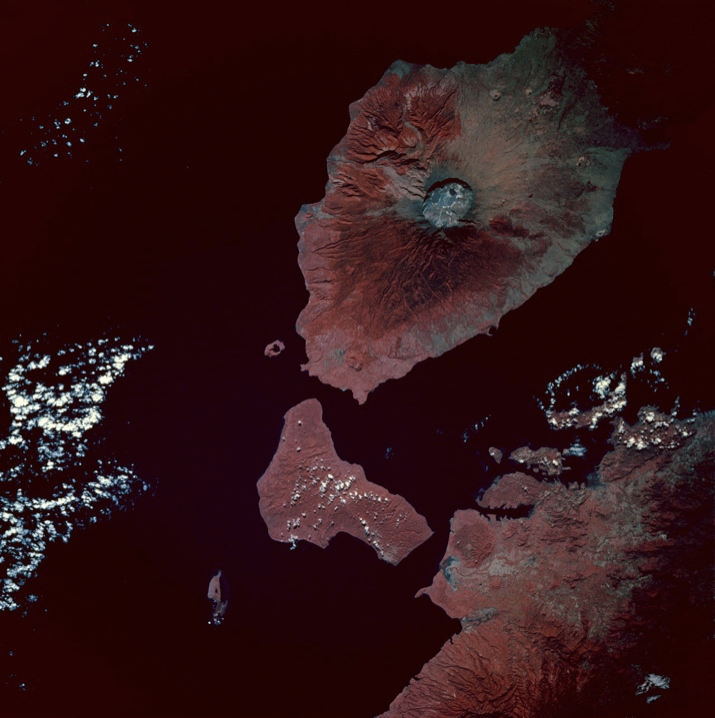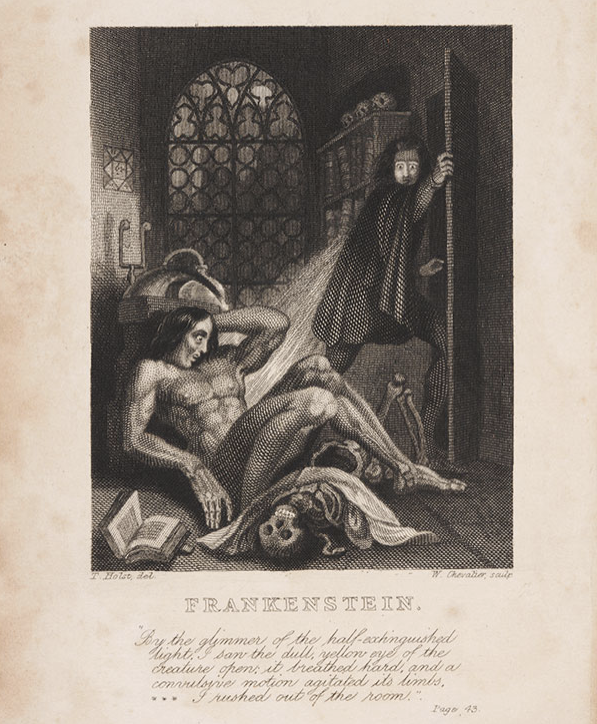Mount Tambora’s most well-known impact has been its claim to influencing one of the most revered literary works in the English canon: Mary Shelley’s Frankenstein; or, The Modern Prometheus (1818). In this short article, I ask readers to take seriously the feeling of ecoanxiety and its relevance in Frankenstein’s creation. Tambora’s eruption, while not directly influencing Shelley, offers an entrance into ecological readings of Frankenstein and its apocalyptic genesis. Ecoanxiety in Frankenstein signals our ability to create art in reaction to environmental disaster in increasingly unstable planetary futures.
On 5 April 1815, Mount Tambora—a volcano on Sumbawa island—began a week of explosions recorded as global history’s most impactful volcanic eruption. These eruptions created columns of volcanic material forming pyroclastic flows of hot ash falling to Earth, destroying crops, killing an estimated 71,000 people, and displacing many more. Quantities of dust and sulphur were ejected into the atmosphere, turning day into night by preventing the sun’s rays from reaching ground, triggering a mini ice age. Tambora’s planetary ecological effects interrupted monsoon seasons in India, increased flooding in China, and everywhere experienced some level of crop failure due to drastically changing weather patterns. Western Europe and North America experienced unusually cold weather during summertime, reporting snowfall throughout June and July across New England’s colonies. Thus, 1816 came to be known as “the year without a summer.” Yet Tambora’s impact is studied less for the ecological havoc it wrecked worldwide and more for its claim to influencing the first Western sci-fi. But how much did Tambora’s eruption impact Shelley? Can a link be drawn between environmental catastrophe and Shelley’s literary creation?

Mount Tambora, taken from the space shuttle Endeavour on 13 May 1992.
Mount Tambora, taken from the space shuttle Endeavour on 13 May 1992.
Photograph by Image Science and Analysis Group, NASA Johnson Space Center. Accessed via Wikimedia Commons. Click here to view source.
 This work is licensed under a Creative Commons Public Domain Mark 1.0 License.
This work is licensed under a Creative Commons Public Domain Mark 1.0 License.
Frankenstein’s mythic conception is as familiar as the narrative it contains. Joined by poet-boyfriend Percy Shelley, infamous poet Lord Byron, his biographer and physician John Polidori, and Mary’s half sister Claire Claremont, Mary Shelley arrived at the rustic Villa Diodati on Lake Geneva in Switzerland during the summer of 1816. Ignorant of Tambora’s eruption altering global geographies, the group was inevitably driven indoors by torrential rains and gloomy skies all summer long. Passing time, they read Fantasmagoriana (1812), a French anthology of German ghost stories, to each other. One such story, “L’amour muet” (“Silent Love”), uses “a furious storm” that found “the poor François . . . drenched to the bones,” as symbolic foreshadowing that leads François to “spot[] a light in the distance,” wherein he discovers a haunted castle (40). Inspired, the Shelley–Bryon coterie decide to hold a ghost storytelling contest of their own, out of which arose the first Western vampire novel—Polidori’s The Vampyre (1819)—and Shelley’s Frankenstein.
Though Shelley did not know Tambora was causing Geneva’s poor clime, its eruption had impacts on her psyche. In her Journals, Shelley writes about the “almost perpetual rain” and flooding during the summer of 1816, a fact verified by London’s Morning Post, which notes rainfall in Geneva nearly doubled from averages in July 1816. More than floods, she notes a “contrary” wind so strong that “vineyards were entirely destroyed in its path, & the earth torn up.” Mary and Percy also heard from locals that “a Savoyard boat had been overturned in the middle of the lake & two women, two cows & twelve black pigs … had been drowned.” Her following entries mention consistent days of “violence of wind & intervals of rain,” which prevent her and Percy from visiting Mer de Glace. When the pair finally ventured to climb the glacier, Shelley notes “the rain continued in torrents—we were wetted to the skin so that when [we] [had] ascended more than half way we resolved to turn back,” but not before Percy fainted from the severe weather. Mary may have experienced a sense of anxiety and discomfort given the summer weather’s turn toward winds and rains capable of wrecking such havoc.

Frontispiece from the 1831 third edition of Shelley’s gothic novel Frankenstein: or, the Modern Prometheus. The novel’s subtitle recalls the myth of Prometheus, a demigod who molded humans out of clay and stole fire from Zeus, providing his creation with life and light. For his presumption, he was sentenced to eternal punishment: chained to a rock and condemned to have an eagle daily feed upon his liver.
Frontispiece from the 1831 third edition of Shelley’s gothic novel Frankenstein: or, the Modern Prometheus. The novel’s subtitle recalls the myth of Prometheus, a demigod who molded humans out of clay and stole fire from Zeus, providing his creation with life and light. For his presumption, he was sentenced to eternal punishment: chained to a rock and condemned to have an eagle daily feed upon his liver.
Illustration by Theodor von Holst. Accessed via Wikimedia Commons. Click here to view source.
 This work is licensed under a Creative Commons Public Domain Mark 1.0 License.
This work is licensed under a Creative Commons Public Domain Mark 1.0 License.
Shelley and her group may not have known why the climate was altered but they sensed ecological disturbance—a “mad disquietude” as Byron wrote in his poem “Darkness” (1816)—and writing ghost stories was one way they acknowledged the “feeling” of ecological disaster. Feeling disaster is made parabolically evident through Shelley’s main character Victor Frankenstein, who represents the “modern Prometheus” named in the novel’s subtitle. Victor is described as “imbued with a fervent longing to penetrate the secrets of nature” (41), and his melancholy wanderings amid the “torrents” of rain to reach the summit of Montanvert unheeded, for “what were rain and storm to me?” (86) speak to his Promethean mindset to conquer nature. Readers see Victor straddling a double nature: standing both for human progress and for humanity’s failings. Victor’s ultimate moral flaw was not in surpassing nature’s bounds or creating a hybrid being, but in disregarding his responsibility toward his creation—a fundamentally environmental issue. We, like Victor, are heedless of the consequences of an climate change that we “created.” While Tambora’s eruption represents a case for ecological catastrophe beyond human control, we can think of the Anthropocene on a similar scale that now far exceeds any one individual.
Today, we call these feelings ecoanxiety. A real psychological diagnosis, “ecoanxiety” has come to the fore in cultural conversations regarding planetary futures. We have collectively undergone catastrophes, from COVID-19 (and its subsequent variants) to rising climate-change disasters that impact not just peoples but animals, coral reefs, and ice caps; the very well-being of the planet is already beyond saving. If art is indeed the world’s mirror, then we can expect ecoanxiety to infuse artistic, literary, and multimodal narratives to come. Mount Tambora’s impact on the genesis of Mary Shelley’s Frankenstein is an example of ecoanxiety caused by climate change beyond human control, but what can we learn from Victor’s own narrative of anthropogenic “change”? Frankenstein represents ecoanxieties through feelings of disaster that impact human psyches and our ability to process traumas now beyond human scale. The increasingly frequent ecological disasters of our world only foreshadow the “Frankensteins” to come.
PRIMARY SOURCES
- Eyriès, Jean-Baptiste Benoît, trans. Fantasmagoriana. 2 vols. Paris: Chez F. Schoell, 1812
-
Shelley, Mary Wollstonecraft. Frankenstein; or, The Modern Prometheus. New York: Barnes and Nobles Classics, 2003. First published 1818 by Lackington, Hughes, Harding, Mavor & Jones.
How to cite
Nelson, Taylin. “Climate Disaster, Ecoanxiety, and Frankenstein: Mount Tambora and Its Aftereffects.” Environment & Society Portal, Arcadia (Summer 2024), no. 8. Rachel Carson Center for Environment and Society. doi:10.5282/rcc/9842.
ISSN 2199-3408
Environment & Society Portal, Arcadia
 This work is licensed under a Creative Commons Attribution 4.0 International License.
This work is licensed under a Creative Commons Attribution 4.0 International License.
2024 Taylin Nelson
This refers only to the text and does not include any image rights.
Please click on an image to view its individual rights status.
- “Dreadful Weather on the Continent.” The Morning Post, 24 July 1816. https://www.bl.uk/collection-items/dreadful-weather-on-the-continent-from-the-morning-post.
- Marshall, Alan, Kanang Kantamurapoj, Nanthawan Kaenkaew, and Mark Felix. “The Tambora – Frankenstein Myth: The Monster Inspired.” Humanities Bulletin 2, no. 2 (2019): 217–35.
- Marshall, Florence A. Thomas, ed. The Life and Letters of Mary Wollstonecraft. 2 vols. London: Richard Bentley & Son, 1889.
- Oppenheimer, Clive. “Climatic, Environmental and Human Consequences of the Largest Known Historic Eruption: Tambora Volcano (Indonesia) 1815.” Progress in Physical Geography 27, no. 2 (2003): 230–59. doi:10.1191/0309133303pp379ra.
- van Woudenberg, Maximiliaan. “The Variants and Transformations of Fantasmagoriana: Tracing a Travelling Text to the Byron–Shelley Circle.” Romanticism 20, no. 3 (2014): 306–20. doi:10.3366/rom.2014.0194.








